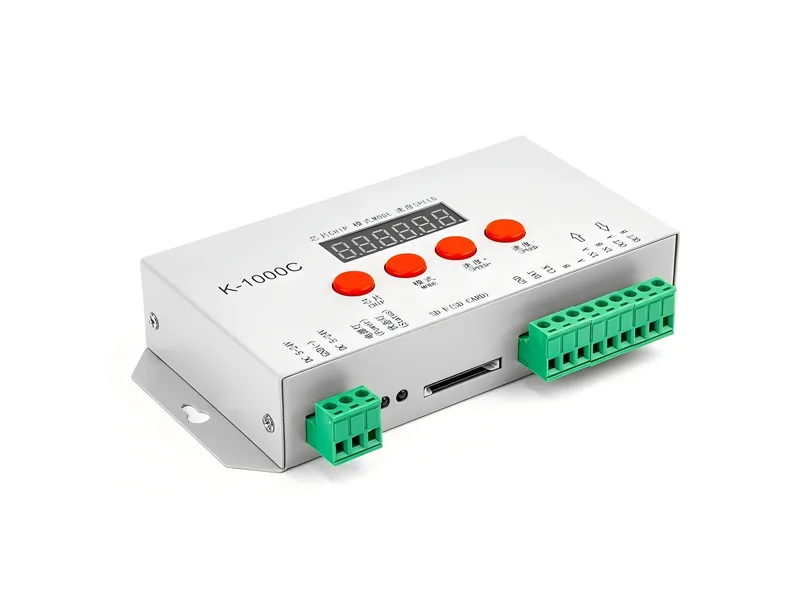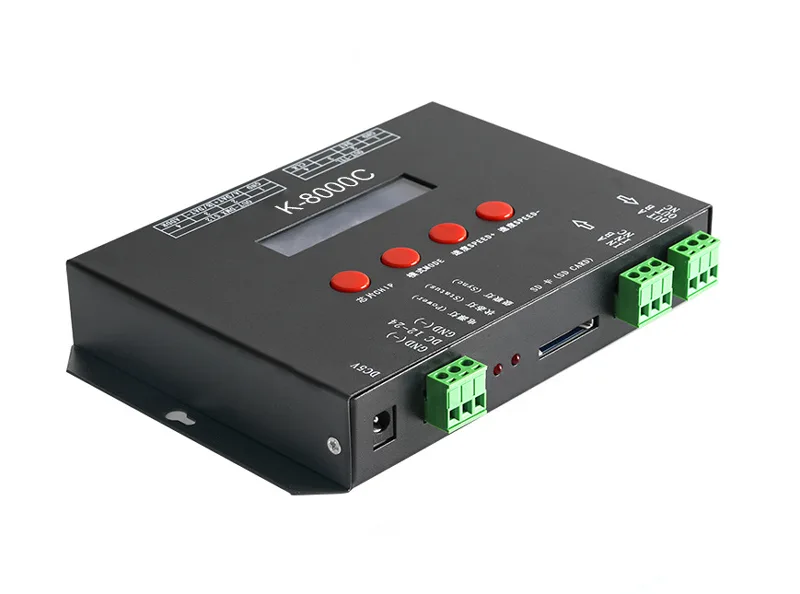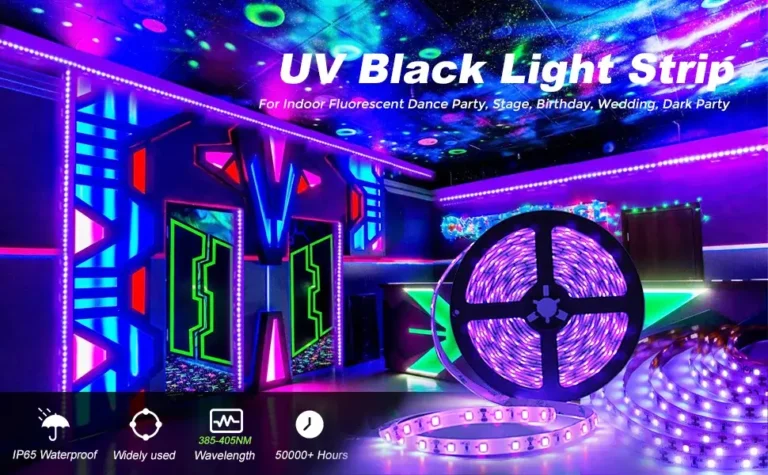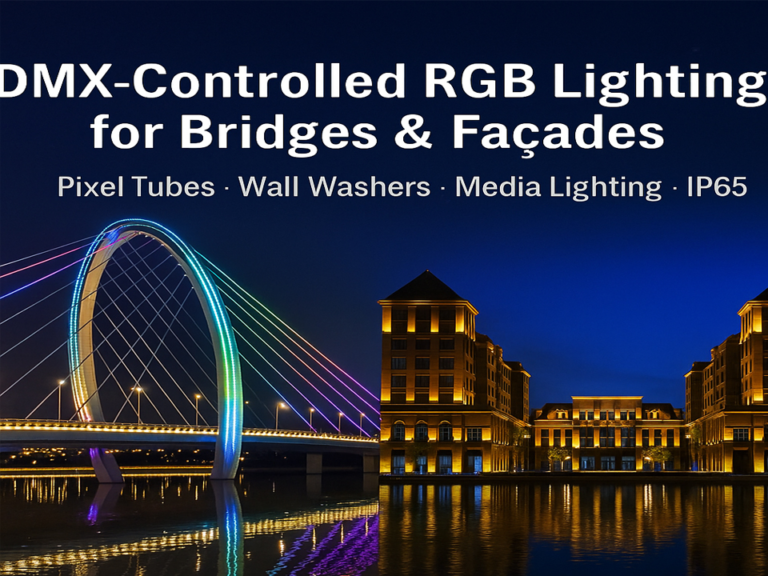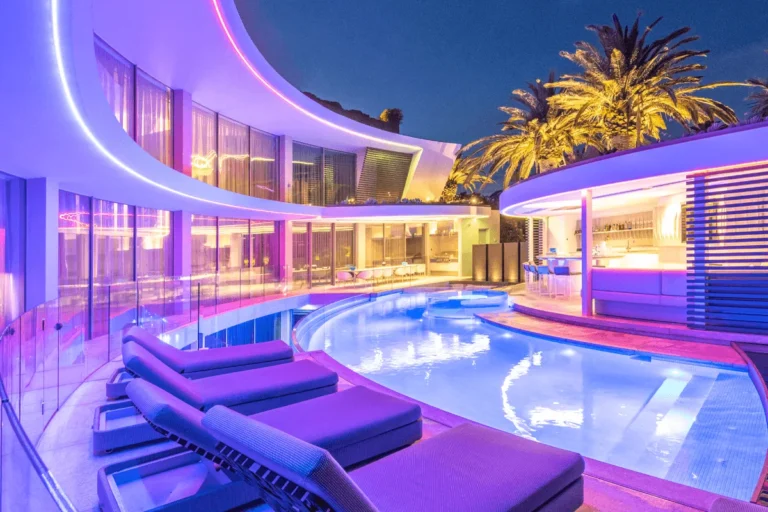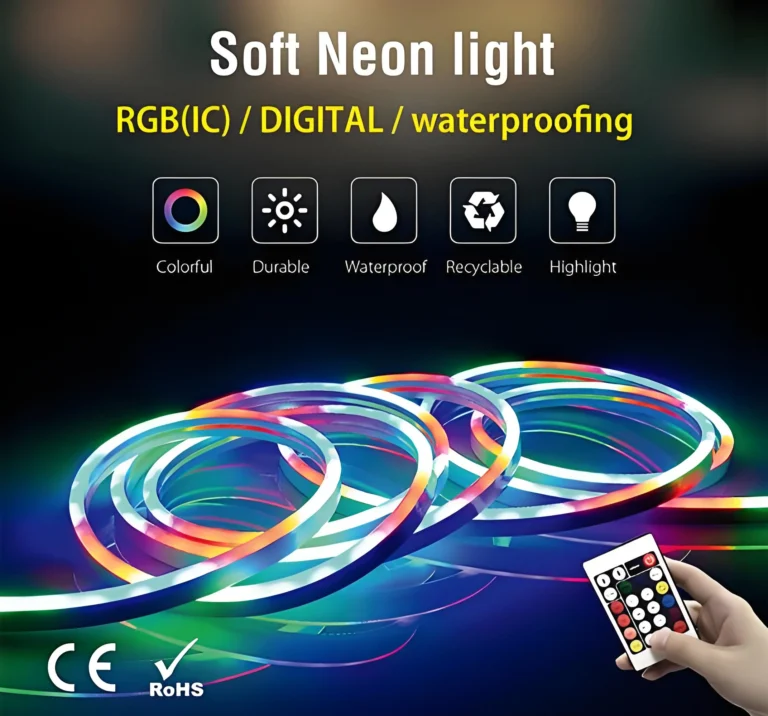Pojawia się nowa generacja oświetlenia architektonicznego LED: Neon LED flex może idealnie pasować do ukształtowanych powłok budynków, zużywa 85% mniej energii niż tradycyjny neon, a dzięki inteligentnemu systemowi sterowania DMX512 można zrealizować 2,56 miliona kombinacji kolorów w jednym budynku.
Spiralny efekt świetlny w Shanghai Center Tower i pikselowy pokaz świetlny w Guangzhou Tower potwierdzają nieskończone możliwości cyfrowego oświetlenia. Na szczególną uwagę zasługuje integracja technologii IOT - system oświetlenia Ping An Building w Shenzhen może reagować na dane PM2.5 w czasie rzeczywistym i wizualizować jakość powietrza w mieście za pomocą światła i cienia. Inteligentne oświetlenie przekształca fasadę budynku w cyfrowe płótno, które można zaprogramować tak, aby płynnie przełączało się między scenami, takimi jak uroczystości świąteczne i kampanie usług publicznych. Światła w mediolańskim Vertical Forest naśladują nawet rytm fotosyntezy drzew, czyniąc budynek żywym organizmem.
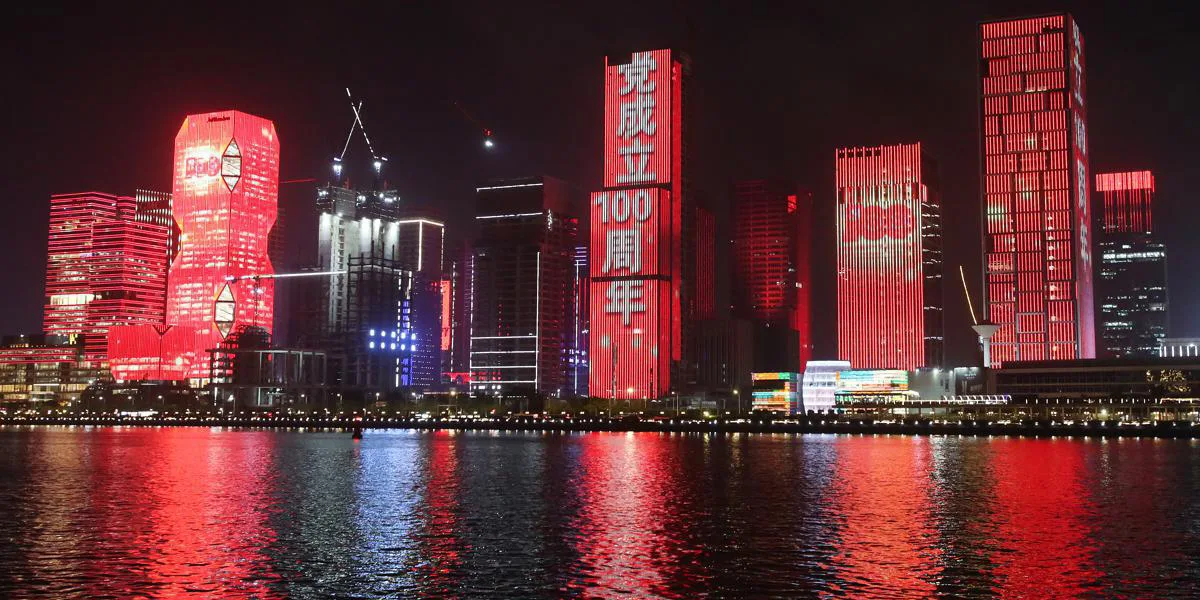
W projektowaniu oświetlenia architektonicznego neon LED Flex sterowany przez DMX zmienia estetykę przestrzenną dzięki swojej doskonałej elastyczności i dynamicznej ekspresji. Dzięki protokołowi DMX512 projektanci mogą precyzyjnie regulować jasność, kolor i dynamikę każdego paska, umożliwiając nieskończoną kreatywność, od stopniowego oddychania po złożone rytmy. Niniejszy przewodnik techniczny analizuje architekturę systemu oświetleniowego DMX, punkty projektowe i wybór produktów konwencjonalnego sprzętu. Mam nadzieję, że jego lektura okaże się pomocna i przyspieszy realizację projektu.
Zalety protokołu DMX512 w inteligentnym oświetleniu
Protokół DMX512 umożliwia sterowanie światłem po świetle za pośrednictwem 512 niezależnych kanałów, które mogą dokładnie sterować wielowymiarowymi parametrami, takimi jak kolor, jasność, efekty dynamiczne itp. w celu spełnienia rygorystycznych wymagań złożonych efektów świetlnych na scenach, takich jak sceny i fasady budynków.
Jego milisekundowa szybkość reakcji zapewnia zsynchronizowane działanie dużych lamp i latarni, co jest szczególnie przydatne w interaktywnych aplikacjach czasu rzeczywistego, takich jak dynamiczne gonienie światła i łączenie muzyki. Przyjmując architekturę master-slave i sygnalizację różnicową, obsługuje do 32 urządzeń w szeregu i tysiące węzłów, zapewniając doskonałą skalowalność systemu.
Standaryzowane interfejsy i silna kompatybilność umożliwiają bezproblemowy dostęp do ściemniaczy, sterowników i różnych typów inteligentnych lamp, w połączeniu z właściwościami przeciwzakłóceniowymi warstwy fizycznej RS485, aby utrzymać stabilną transmisję w złożonym środowisku elektromagnetycznym projektu.
Te właściwości techniczne sprawiają, że DMX jest preferowanym rozwiązaniem sterowania w dziedzinie przedstawień na dużą skalę, krajobrazów tematycznych, fasad budynków i innego profesjonalnego oświetlenia.
Dlaczego warto używać neonowego flexu LED do oświetlenia architektonicznego?

Wykorzystanie Elastyczne taśmy neonowe LED do oświetlenia architektonicznego ma wiele zalet. Po pierwsze, jego super elastyczność może pasować do złożonych zakrzywionych powierzchni lub ukształtowanych struktur, łatwo realizować zarys budynku, dekorację elewacji, otoczenie kopuły i inne kreatywne projekty, nadając sztuce oświetleniowej większą siłę wyrazu.
Taśma neonowa ma modułową konstrukcję, którą można dowolnie ciąć i łączyć w celu dopasowania do różnych rozmiarów scenariuszy instalacji, co znacznie zmniejsza trudność konstrukcji.
Po drugie, źródło światła LED charakteryzuje się wysoką wydajnością świetlną i niskim zużyciem energii, z inteligentnym systemem ściemniania, wydajnością energetyczną w porównaniu z tradycyjnym oświetleniem w celu zwiększenia ponad 50% i niskim wytwarzaniem ciepła, zmniejszając obciążenie cieplne budynku.
Po trzecie, obsługuje mieszanie światła RGB w pełnym kolorze i dynamiczne programowanie oraz osiąga gradient kolorów, działające światła, połączenie muzyczne i inne efekty za pośrednictwem protokołów DMX lub bezprzewodowych, co zwiększa interaktywność i technologiczny sens architektonicznej sceny nocnej.
Ponadto, zewnętrzna warstwa elastycznego paska jest pokryta silikonem lub żywicą epoksydową, z klasą wodoodporności do IP67 lub wyższą, dużą odpornością na warunki atmosferyczne, możliwością dostosowania do różnic temperatur zewnętrznych, deszczu i środowiska ultrafioletowego oraz żywotnością do 50 000 godzin, co znacznie zmniejsza koszty konserwacji. Niskonapięciowe zasilanie (12/24 V) zwiększa również bezpieczeństwo elektryczne, dzięki czemu jest to preferowane rozwiązanie dla nowoczesnych projektów oświetlenia architektonicznego.
Czym jest system DMX512?
DMX512 (Digital Multiplex 512) to standard cyfrowego protokołu sterowania szeroko stosowany w dziedzinie oświetlenia scenicznego, oświetlenia architektonicznego itp. Umożliwia on precyzyjne sterowanie urządzeniami za pomocą sygnałów cyfrowych. Jego podstawową zasadą jest przesyłanie poleceń sterujących za pośrednictwem komunikacji szeregowej, a każde łącze sygnału DMX składa się z kontrolera głównego (np. konsoli ściemniacza) i wielu urządzeń podrzędnych (opraw, ściemniaczy itp.). System opiera się na standardzie warstwy fizycznej RS-485, wykorzystując technologię transmisji sygnału różnicowego, z silną zdolnością przeciwzakłóceniową i maksymalną odległością transmisji do 1200 metrów (wymagana jest rozbudowa repeatera).
Każda ramka danych DMX zawiera 512 niezależnych kanałów sterowania; każdy kanał odpowiada 8-bitowym danym (zakres wartości 0-255), które mogą regulować jasność, kolor, ścieżkę ruchu i inne parametry lamp. Na przykład, oprawa LED RGB zwykle zajmuje 3 kanały (po 1 kanale dla koloru czerwonego, zielonego i niebieskiego) i może odbierać odpowiednie polecenia po ustawieniu numeru kanału początkowego za pomocą enkodera adresu. Kontroler wysyła pakiety danych cyklicznie z maksymalną szybkością 250 kb/s, odświeżając je około 44 razy na sekundę, aby zapewnić synchronizację zmian oświetlenia w czasie rzeczywistym. System obsługuje łańcuchową strukturę szeregową; pojedyncza linia może kontrolować do 32 urządzeń, a dzięki rozdzielaczowi można ją rozszerzyć do tysięcy węzłów, aby zaspokoić potrzeby dużych projektów oświetleniowych.
Skład systemu DMX512 obejmuje głównie następujące części:
Konsola DMXgłówne urządzenie wysyłające sygnały sterujące (takie jak konsola oświetleniowa lub oprogramowanie).
Odbiornik DMXModuł dekodujący w urządzeniu lub innym sprzęcie, odbierający i wykonujący polecenia.
Kabel DMX: Specjalistyczna ekranowana skrętka dwużyłowa z 5-pinowym lub 3-pinowym złączem XLR.
Rezystor terminujący: Rezystor (zwykle 120 Ω) jest instalowany na końcu łańcucha sygnału, aby zapobiec zakłóceniom odbicia sygnału.
Jakie są cechy taśmy neonowej DMX512?
- Taśma neonowa DMX Pixel składa się z wielu niezależnie sterowanych kulek LED (pikseli). Każdy piksel może być indywidualnie regulowany pod względem koloru (np. RGB/RGBW) i jasności, tworząc dynamiczne wzory lub efekty gradientu. Każdą diodę LED można zaprogramować niezależnie, aby uzyskać delikatne efekty animacji (np. płynąca woda, miganie, zanikanie).
- W porównaniu z tradycyjnymi lampami neonowymi jest bardziej energooszczędny, trwały i obsługuje sterowanie programowe.
- Taśma neonowa LED owinięta elastycznymi materiałami (np. silikon, PVC) może być dowolnie wyginana i cięta, aby dostosować się do środowiska instalacji o złożonych kształtach (np. zakrzywione powierzchnie, zakrzywione konstrukcje).
- Transmisja na duże odległości (do 1200 metrów), wysoka kompatybilność i możliwość sterowania wieloma urządzeniami jednocześnie.
- Obsługuje wyświetlanie w wysokiej rozdzielczości, odpowiednie dla tekstu, wzorów i ruchomych obrazów.
- Wysyłaj polecenia za pośrednictwem sterownika DMX, który można zsynchronizować z innymi urządzeniami oświetlenia scenicznego, takimi jak ruchome głowy, światła laserowe itp. w celu uzyskania jednolitego efektu.
- Obsługuje rozbudowę o wiele wszechświatów, aby spełnić potrzeby instalacji na dużą skalę (np. fasada budynku, duża scena).
- Wysoka klasa wodoodporności, odporna na trudne warunki zewnętrzne, zwykle do IP65 lub IP67, odpowiednia do użytku wewnątrz i na zewnątrz.
- Konstrukcja z możliwością cięcia: dostosuj długość w razie potrzeby, zmniejszając złożoność instalacji.
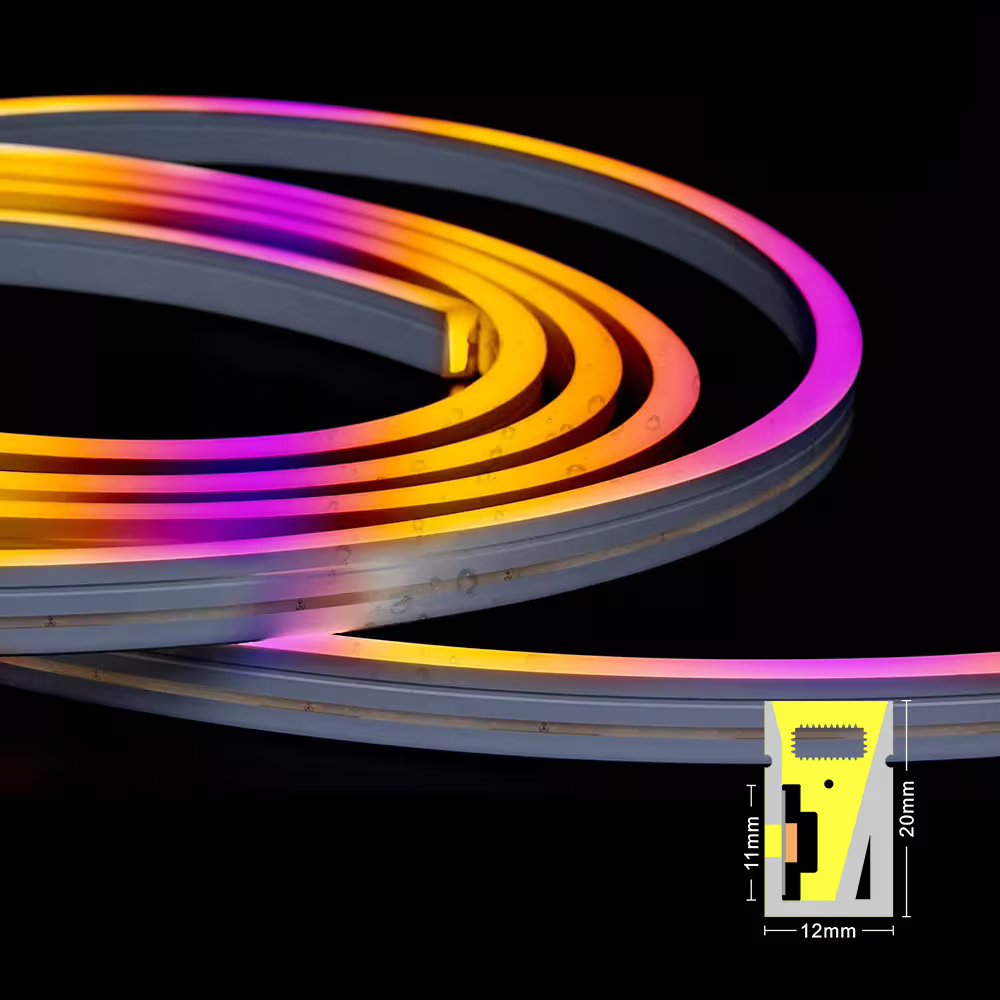
Side Bend S1220 Silikonowa adresowalna taśma neonowa LED do oświetlenia architektonicznego, ściennego i elewacyjnego
Napięcie wejściowe: DC24V
Watt: 12W/m@RGB, 19W/m@RGBW
ILOŚĆ diod LED: SMD5050 60 diod LED/m
Temperatura barwowa: RGB/RGBW(2700K-6500K)
Typ sygnału: SPI/DMX512
Stopień ochrony IP: IP65/IP67
Wejście kablowe: Przód
Minimalna średnica gięcia: 100 mm
Długość cięcia: 100 mm
Długość: 5 metrów/rolka
Jak DMX512 steruje taśmą neonową LED?
Sterownik DMX512 wysyła polecenia do systemu taśm neonowych LED za pośrednictwem sygnałów cyfrowych (zgodnie ze standardem RS-485); sygnał jest analizowany przez dekoder, a następnie dopasowuje dane kanału RGB każdego piksela LED zgodnie z ustawionym adresem, aby niezależnie regulować jasność (poziom 0-255) i kolor. Dzięki programowaniu zaprogramowanych scen lub sterowaniu w czasie rzeczywistym w celu uzyskania dynamicznych gradientów, zsynchronizowanego migania i innych efektów mających zastosowanie do sceny, budynku i innych scen, aby zapewnić współpracę wielu urządzeń i przeciwdziałanie zakłóceniom, określone połączenia sterujące odnoszą się do poniższego schematu obwodu.
Schemat połączeń systemu DMX512:
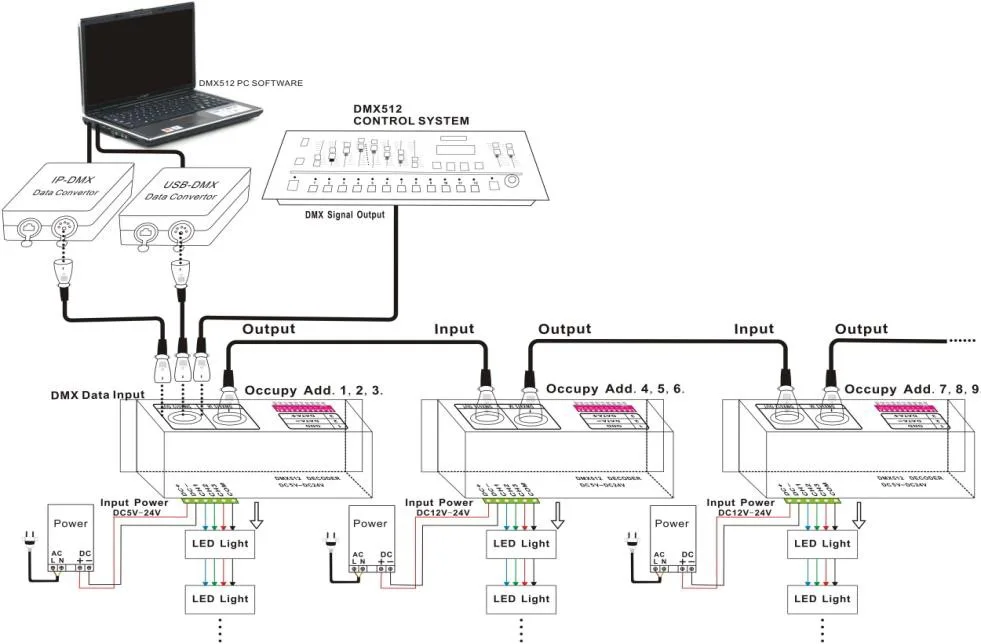
Wybór urządzenia sterującego DMX512
I. DMX512 Master
Mastery DMX512 wysyłają sygnał międzynarodowego standardu DMX512/1990 do dekoderów DMX512 w celu sterowania przyciemnionym oświetleniem LED jednokolorowym, dwukolorowym CCT, RGB, RGBW i RGB+CCT. Dwa najczęściej używane są następujące:
1. Kontroler DMX512 z panelem dotykowym: Obsługuje wyjście DMX512, z wbudowanym ściemnianiem, regulacją temperatury barwowej, funkcjami sterowania RGB/RGBW i możliwością zarządzania strefami (do 4 stref) oraz integruje wiele trybów dynamicznych (takich jak gradient i skok). Jego konstrukcja instalacyjna typu 86 jest odpowiednia dla scenariuszy komercyjnych lub domowych.
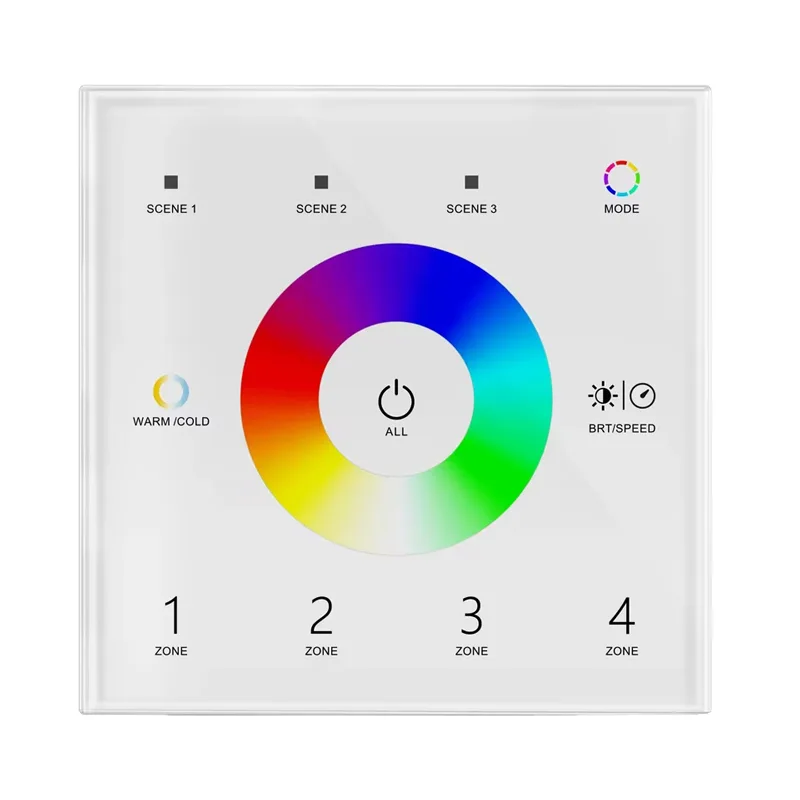
Naścienny panel dotykowy DMX512 T15
Panel dotykowy 4-strefowy 1-5-kolorowy master DMX512 może być również używany jako 4-strefowy 1-5-kolorowy pilot RF.
Wyjście sygnału DMX, zgodne ze standardowym protokołem DMX512, kompatybilne z dekoderem DMX dowolnego dostawcy.
W przypadku użycia jako pilot RF, każda strefa może zdalnie sterować wieloma sterownikami LED RF 2.4G, sterownikami ściemniania lub inteligentnymi lampami.
Ultra czuły, o wysokiej wytrzymałości.
Pobierz kartę katalogową ściennego panelu dotykowego DMX512 T15
Cena: 24,98 USD/szt.
2. Sterowanie DMX512r: Sterownik DMX512 jest podstawowym urządzeniem używanym do scentralizowanej regulacji i sterowania oświetleniem scenicznym i sprzętem do efektów specjalnych oświetlenia architektonicznego. Przesyła on instrukcje za pośrednictwem sygnałów cyfrowych opartych na protokole DMX512. Może zarządzać wieloma urządzeniami (takimi jak lampy i silniki) jednocześnie, precyzyjnie dostosowywać parametry, takie jak jasność, kolor i efekty dynamiczne, a także identyfikować odpowiednie dane kanału dla każdego urządzenia za pomocą niezależnego adresu. Obsługa programowania zaprogramowanych scen lub sterowania w czasie rzeczywistym w celu uzyskania synchronizacji i automatyzacji zmian oświetlenia.
Modele K-1000C i K-8000C nadają się do sterowania w trybie offline. Mogą być używane w pojedynczej jednostce lub w wielu kaskadach do sterowania większą liczbą pikseli LED.
a. Jeśli główna lampa ma mniej niż 80 000 pikseli, zaleca się użycie sterownika pikseli DMX K-1000C.
b. Jeśli główna lampa ma od 8000 do 20 000 pikseli, zaleca się użycie sterownika pikseli LED DMX K-8000C.

II. Dekoder DMX-SPI
Konwersja sygnału DMX512 na protokół rozpoznawany przez taśmy LED (np. SPI). Na przykład używane są układy takie jak TM1803 i UCS512, z których każdy odpowiada kontroli kanału RGB jednego lub więcej pikseli LED.
Każdy piksel LED musi mieć przypisany niezależny kod adresowy, a sterowanie punkt po punkcie odbywa się poprzez mapowanie kanałów (na przykład piksele RGB zajmują trzy kanały DMX).
Można nim sterować za pomocą konsoli DMX i podłączyć wiele dekoderów DMX, aby zwiększyć moc wyjściową i osiągnąć wszystkie funkcje. Różne tryby zmiany. Ponadto dekoder DMX może być również używany jako synchronizator. Kontroler oddzielnie steruje diodą LED, aby uzyskać efekt synchronizacji.
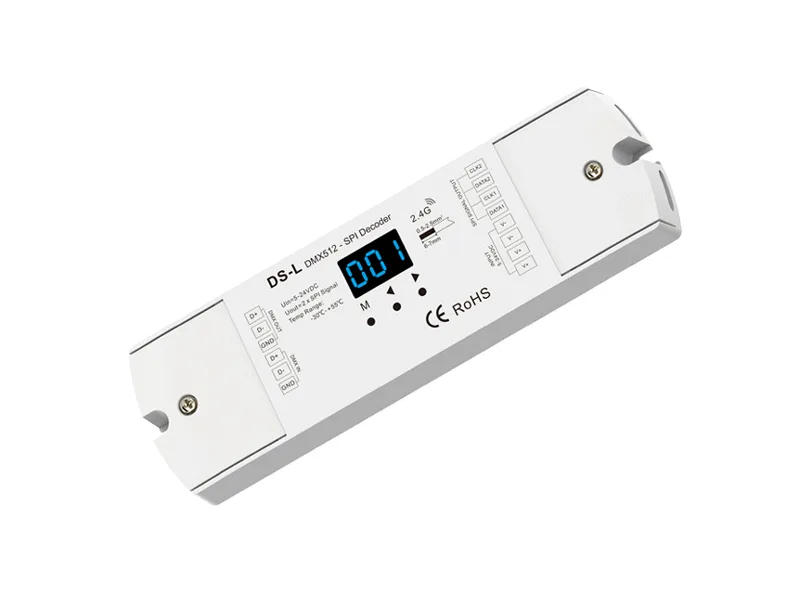
Dekoder DMX na SPI RGB RGBW i kontroler RF
Model: CTL-RGB-DMX-DS-L
Napięcie zasilania: DC5V~24V
Pobór mocy: 1W
Sygnał wejściowy: DMX512 + RF 2,4 GHz
Sygnał wyjściowy: SPI(TTL) x 3/4 kanały
Tryb dynamiczny: 32
Punkty kontrolne: 170 pikseli (RGB 510 CH), maks. 900 pikseli
Wymiary: L175 x W54 x H27mm
Pobierz kartę katalogową CTL-RGB-DMX-DS-L
Cena: 16,98 USD/szt.
III. Wzmacniacz sygnału DMX DA do wodoodpornych taśm neonowych LED
Służy do zwiększenia odległości transmisji sygnałów DMX, obsługując 1 wejście i wiele wyjść. Zwiększa stabilność sygnału dzięki technologii izolacji fotoelektrycznej i nadaje się do pracy na duże odległości lub w złożonych środowiskach elektromagnetycznych.
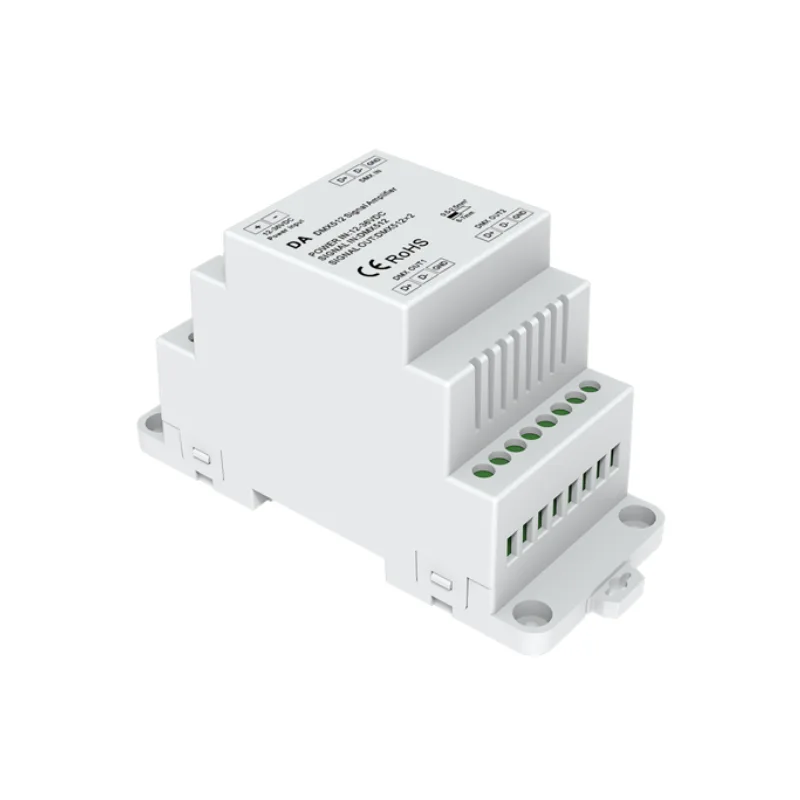
Wzmacniacz sygnału DA DMX
2-kanałowy wzmacniacz sygnału DMX 512.
Jedno wejście sygnału DMX512, dwa wyjścia sygnału DMX512. Dedykowany do wzmacniania, dystrybucji i izolowania sygnału pochodzącego ze sprzętu oświetleniowego DMX, gdy jest on podłączony do magistrali DMX512 (lub RS-485).
Wydłużenie odległości transmisji sygnału.
Sterowanie wyjściem rozszerzenia sygnałów; zwiększenie wzmacniacza sygnału DMX (485) w celu dystrybucji sterowania wielokanałowego.
Cena: 24,98 USD/szt.
Jak skonfigurować zasilacz?
System taśm neonowych LED DMX512 zazwyczaj składa się z wielu segmentów świetlnych, które muszą rezerwować margines zgodnie z całkowitą mocą obciążenia i dynamicznymi zmianami.
1. Obliczanie całkowitej mocy obciążenia: P całkowite = ∑ (moc pojedynczej sekcji świetlnej × liczba)
Moc pojedynczej sekcji światła: Moc taśmy neonowej LED DMX512 na metr lub na sekcję (np. 5 W/m).
Przykład: Jest 10 odcinków taśmy świetlnej, każdy odcinek o długości 3 metrów, z mocą na metr wynoszącą 8 W. Łącznie = 10 × 3 × 8 = 240 W
2. Obliczanie mocy znamionowej zasilaczamoc = P całkowita × (1 + współczynnik bezpieczeństwa) ÷ sprawność energetyczna + P (sterownik DMX)
Współczynnik bezpieczeństwa: Zaleca się przyjęcie 0,2~0,3 (w systemie DMX mogą występować częste przyciemnienia i wahania natężenia prądu).
Wydajność energetyczna: zwykle 85%~95% (zasilacz impulsowy jest bardziej wydajny).
Pobór mocy sterownika DMX: zwykle 5~20 W (należy sprawdzić konkretny model).
Przykład:
Całkowite obciążenie 240 W, współczynnik bezpieczeństwa 0,3, sprawność zasilacza 90%, pobór mocy kontrolera 15 W:
Zasilanie = 240X1,3÷0,9+15≈303+15=362W
Należy wybrać zasilacz o mocy ≥ 360 W.
Markowe zasilacze (np. seria Mean Well XLG), aby zminimalizować zakłócenia sygnału i problemy ze spadkiem napięcia. Zapewnij stabilne napięcie (zwykle DC12V lub 24V), aby dopasować moc listwy świetlnej (np. 12W/m@RGB).
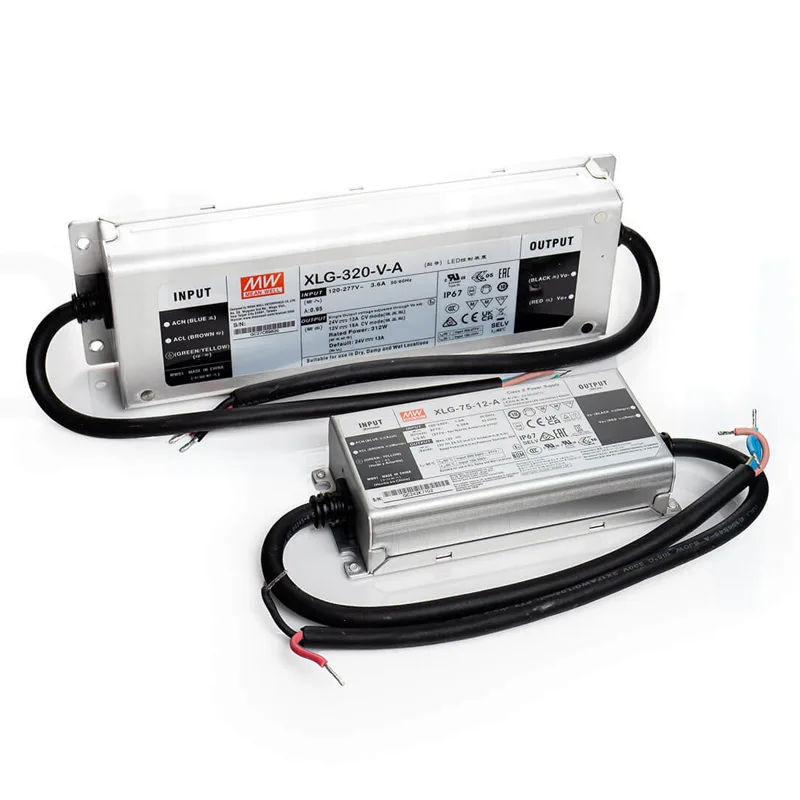
Stałonapięciowy zasilacz LED Mean Well serii XLG IP67
- Model: XLG-75, XLG-100, XLG-150, XLG-200, XLG-320
- Napięcie wejściowe: AC100-305V
- Napięcie wyjściowe: DC12V/DC24V
- Prąd wyjściowy: 5 A-18 A przy DC24 V, 3,1 A-13 A przy DC12 V
- Moc: 75W-320W
- Skuteczność: 89%-94%
- PF: >0,95
- Ściemnianie: możliwość ściemniania 3 w 1
- Stopień ochrony IP: IP67
- Certyfikaty: UL, CE, ROHS
- Gwarancja: 5 lat
Co to jest spadek napięcia?
Mówiąc najprościej, spadek napięcia to strata energii, która występuje podczas przepływu napięcia w obwodzie, gdy prąd przepływa przez oprawę LED. Proces ten jest podobny do przepływu wody przez wąską rurę; prędkość wody będzie spowodowana tarciem, co spowoduje pewne straty energii. W przypadku lamp i latarni LED spadek napięcia prowadzi do niewystarczającej mocy wyjściowej, wpływając na skuteczność świetlną i żywotność lamp i latarni.
Problem spadku napięcia taśmy LED występuje, gdy taśma LED jest podłączona do zasilania, ze względu na długość obwodu i mały prąd spowodowany utratą napięcia, co powoduje, że jasność taśmy LED nie jest wystarczająca lub nierówna. Problem ten jest bardzo uciążliwy dla użytkowników, którzy używają taśm LED od dłuższego czasu, więc muszą szukać rozwiązania!
Przyczyny spadku napięcia taśmy LED:
- Mniejszy prądPrąd w taśmach LED jest zwykle niewielki, zwykle od 0,02 do 0,03 A. W rezultacie utrata napięcia występuje nawet w krótkich liniach i jest bardziej widoczna w przypadku długich linii.
- Długość linii: Ogólnie rzecz biorąc, im dłuższa linia między sterownikiem a taśmą LED, tym bardziej oczywisty jest problem spadku napięcia.
- Kwestie jakości: Jakość taśmy LED może mieć również wpływ na spadek napięcia. Niektóre taśmy LED niskiej jakości mogą mieć problemy ze spadkiem napięcia z powodu nadmiernej lub niewystarczającej rezystancji wewnętrznej, co może zwiększyć rezystancję linii.
Jak wybrać przewody do instalacji taśmy neonowej LED?
System DMX512 zasilany jest niskim napięciem (12V/24V DC), prąd linii jest duży, problem spadku napięcia jest szczególnie widoczny i należy upewnić się, że napięcie końcowe jest stabilne.
Aby zapewnić spójność jasności światła przed i za koralikami lampy oraz uniknąć wpływu spadku napięcia na pasek świetlny, zwykle możemy zastosować następujące metody:
Zwiększenie średnicy przewodu: zmniejszenie rezystancji przewodu (typowa średnica przewodu: 1,5 mm², 2,5 mm²).
Segmentowane zasilanie: W przypadku okablowania na duże odległości należy podzielić zasilanie na wiele obwodów.
Zwiększenie napięcia zasilania: Jeśli spadek napięcia na końcu jest zbyt duży, należy użyć zasilacza o nieco wyższym napięciu (np. zaprojektować system 24 V zamiast 12 V).
Aby prawidłowo poradzić sobie ze spadkiem napięcia, ale także nie polegać na przewodniku w celu zwiększenia średnicy przewodu, należy wziąć pod uwagę zwiększone koszty i racjonalność okablowania. Możemy prawidłowo wybrać następujące kroki, aby dodatkowo zrekompensować problem spadku napięcia.
Krok 1. Obliczanie prądu zaczepu
System DMX jest zwykle podzielony na wiele obwodów sterujących, które muszą być obliczane indywidualnie dla każdego obwodu obciążenia:
I single = P single / V work
Przykład: pojedyncze obciążenie 3 sekcji listwy (3 m × 8 W/m × 3 sekcje = 72 W), napięcie robocze wynosi 24 V.
I pojedynczy obwód = 72/24 = 3,0A
Krok 2: Obliczenie spadku napięcia
R=ρ×(2L/A)
ΔU=I pojedynczy obwód×R linia
Kluczowe parametry:
ρ: rezystywność drutu miedzianego przyjęta jako 0,0172 Ω-mm²/m.
L: odległość w jedną stronę od źródła zasilania do końca (jednostka: metr).
A: Pole przekroju poprzecznego przewodu (jednostka: mm²).
2L: Całkowita długość bieżącej ścieżki podróży w obie strony wynosi 2L.
Przykład:
Prąd pojedynczego obwodu 3 A, długość linii jednokierunkowej 15 metrów, przewód miedziany 1,5 mm²:
R = 0,0172 x (2 x 15/1,5) = 0,344 Ω
Spadek napięcia: ΔU=3AX0.344Ω≈1.032VV
Napięcie końcowe: 24V-1.032V=22.97V (spadek napięcia 4.29%, zgodnie z wymaganiami ≤5%).
Dopuszczalny spadek napięcia: zwykle nie może przekraczać 5%-10% napięcia roboczego (spadek napięcia systemu 12V ≤ 0,6-1,2V, systemu 24V ≤ 1,2-2,4V).
Środki ostrożności:
1. Rozdzielenie sygnału i zasilania: Zaleca się stosowanie niezależnego źródła zasilania. Zaleca się, aby kontroler DMX i taśma świetlna LED były zasilane niezależnie, aby uniknąć zakłóceń.
2. Ekranowany przewód: Linia sygnałowa DMX musi być skręcona ekranowanym przewodem (np. CAT5e) i znajdować się w odległości ponad 30 cm od linii zasilania.
3. Strategia zasilania segmentowego: W przypadku instalacji na dużych odległościach należy ustawić punkt zasilania co 20-30 metrów, aby zmniejszyć spadek napięcia w pojedynczym obwodzie.
4. Synchronizacja zasilania: Gdy wiele zasilaczy jest połączonych równolegle, należy zapewnić wspólną masę lub użyć modułu synchronizacji, aby uniknąć różnic potencjałów zakłócających sygnały DMX.
5. Pomiar napięcia końcowego: Użyj multimetru, aby potwierdzić, że napięcie końcowe wynosi ≥90% napięcia znamionowego.
6. Test stabilności sygnału: Sprawdź, czy sygnał DMX nie migocze lub nie gubi pakietów z powodu zakłóceń zasilania.
7. Test wzrostu temperatury: Po 1 godzinie pracy z pełnym obciążeniem temperatura powierzchni zasilacza powinna wynosić ≤60℃.
Informacje na temat instalacji na zewnątrz można znaleźć w tym poście: Zewnętrzne rozwiązania montażowe LED Neon Flex dla architektów i instalatorów.
Streszczenie
Sterowanie DMX LED Neon Flex stał się idealnym wyborem dla projektów oświetlenia architektonicznego dzięki znormalizowanemu protokołowi i wysokiej zdolności przeciwzakłóceniowej.
Technologia ta umożliwia precyzyjne sterowanie oświetleniem za pośrednictwem protokołu DMX512, obsługuje transmisję sygnału na duże odległości (do setek metrów) i synchronizację wielu węzłów, a także może elastycznie dostosowywać jasność, kolor i efekty dynamiczne, co jest odpowiednie do dekoracji elewacji budynków, oświetlenia krajobrazu i innych scenariuszy.
Wykorzystuje technologię różnicowej transmisji sygnału, aby skutecznie unikać zakłóceń elektromagnetycznych i obsługuje funkcję transmisji punktu przerwania w celu zwiększenia stabilności systemu. Praktyczne zastosowania wymagają zwrócenia uwagi na ustawienia adresów i planowanie linii, takie jak użycie edytora adresów DMX512 do skonfigurowania adresu lamp i latarni oraz, za pośrednictwem kontrolera (np. platformy Interact IoT), w celu osiągnięcia scentralizowanego zarządzania i optymalizacji zużycia energii i wydajności konserwacji.
W połączeniu z inteligentnym ściemnianiem i sterowaniem strefowym, system neonów LED DMX512 może zapewnić precyzyjną kontrolę i równomierną jasność dzięki rozsądnej konstrukcji, zapewniając jednocześnie długotrwałą niezawodną pracę.
